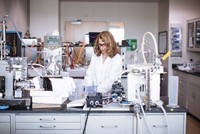Advertisement
Grab your lab coat. Let's get started
Welcome!
Welcome!
Create an account below to get 6 C&EN articles per month, receive newsletters and more - all free.
It seems this is your first time logging in online. Please enter the following information to continue.
As an ACS member you automatically get access to this site. All we need is few more details to create your reading experience.
Not you? Sign in with a different account.
Not you? Sign in with a different account.
ERROR 1
ERROR 1
ERROR 2
ERROR 2
ERROR 2
ERROR 2
ERROR 2
Password and Confirm password must match.
If you have an ACS member number, please enter it here so we can link this account to your membership. (optional)
ERROR 2
ACS values your privacy. By submitting your information, you are gaining access to C&EN and subscribing to our weekly newsletter. We use the information you provide to make your reading experience better, and we will never sell your data to third party members.
Awards
EPA Green Chemistry Challenge Awards announced in hybrid meeting
Awardees recognized for improving the sustainability of various chemical processes
by Leigh Krietsch Boerner
June 6, 2022

This year’s US Environmental Protection Agency (EPA) Green Chemistry Challenge awards were announced in a hybrid in-person/virtual ceremony on June 6. Three companies and two academic researchers received awards for their efforts to practice and advance green chemistry methods in five categories. Some of the work honored included using electrochemistry to form CH bonds, a more efficient way to make a COVID-19 drug, and a renewable way to control insects. The awards were given at the American Chemical Society Green Chemistry & Engineering conference, held in Reston, Virginia and online this year.
“As the Green Chemistry Challenge Awards prove, more sustainable alternatives to traditional chemistries and chemical technologies that meet or exceed the performance requirements of existing products and processes can and are being developed,” Thomas Connelly, CEO of the American Chemical Society said in a statement. ACS publishes C&EN.
Song Lin, an organometallic and electrochemist at Cornell University, won the academic category for his work on transition metal-free coupling and C–H functionalization electrochemistry. These reactions are crucial in making drugs and other complex organic compounds. Traditional transition metal-based catalysts are expensive and create potentially hazardous waste. Song figured out that he could replace the catalysts with carbon and magnesium electrodes, while also ditching any harsh oxidants or reductants typically used in the reactions. His method can be used in industry, and uses less energy than current practices.
In the greener synthetic pathways category, the award went to Merck & Company, Inc. for finding a greener way to make the COVID-19 antiviral drug Molnupiravir. The Merck team developed a short, efficient synthesis of the drug, which increases the overall yield of Molnupiravir while reducing both waste and energy use. The new method also uses readily available starting materials, and allows for purification in water, replacing some organic solvents.
The biotechnology company Amgen’s work on the lung cancer drug Lumakras (sotorasib) won them the greener reaction conditions award this year. The traditional synthesis produces two versions of the drug, but one is much more potent than the other. Amgen’s scientists developed a one-pot synthesis with fewer steps and they cut out a number of isolation and purification steps, which all use organic solvents and energy. The team also found a way to recycle the unwanted version of the drug and use it to make the more potent form. Amgen estimated that the new process will generate about 31.7 million pounds less waste per year.
Provivi, a small agricultural chemicals company co-founded by Nobel laureate Frances Arnold, took home the small business award for creating a greener treatment for fall armyworm moths. These insects destroy more than 80 varieties of crops, including corn and cotton. The treatment, ProviviFAW, is a pheromone that muddles the mating behavior of male moths, resulting in fewer fall armyworm larvae. To synthesize this molecule, scientists at Provivi swapped fossil fuel-based starting materials for renewable plant oils made by fermentation. This switch trimmed down the amount of organic waste, by-products, and steps needed in the synthesis.
The EPA awarded the prize for specific environmental benefit to chemist Mark Mascal and the University of California, Davis, for designing an inexpensive biobased feedstock to replace one made from food biomass. Using food biomass as a feedstock uses up resources that are already in demand, so scientists are looking for another biomass source. The team made the new compound, 5-(chloromethyl)furfural (CMF), by reacting raw biomass with acid. The synthesis of the food biomass compound, 5-(hydroxymethyl)furfural (HMF), does not work on an industrial scale, but the CMF synthesis does. CMF also can be used as a starting material for more compounds than HMF. In addition, scientists can use CMF to make poly(ethylene terephthalate), also known as PET plastic, which is used for myriad industrial and commercial products.
UPDATE:
This story was updated on June 7, 2022, to add a photo from the Green Chemistry Challenge award ceremony.





Join the conversation
Contact the reporter
Submit a Letter to the Editor for publication
Engage with us on Twitter